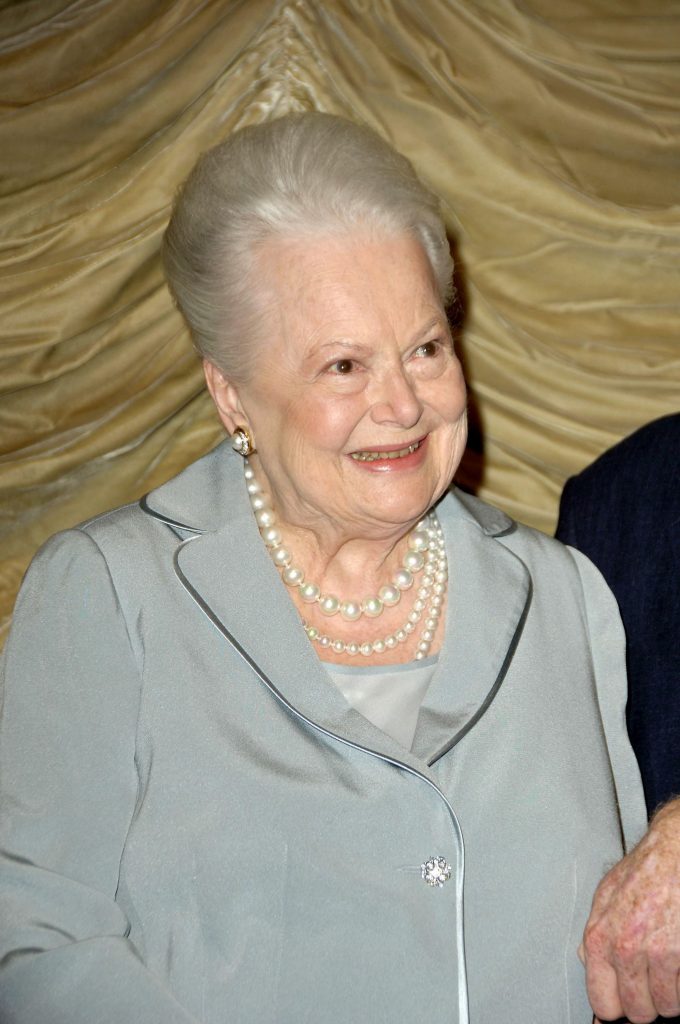By Sean M. Wright
While arranging a picnic and concert with family and friends under the stars at the Hollywood Bowl, I was reminded of the 1934 production of “A Midsummer Night’s Dream” performed at the Bowl, helmed by innovative Austrian director Max Reinhardt.
The 18-year-old actress who played Hermia repeated the role for the 1935 film version after being placed under a then-standard five-year contract by Warner Brothers Studios. She went on to create a number of significant film roles and gave her name to a landmark legal decision.
Today, July 1, 2016, is the 100th birthday of Olivia de Havilland, the last of the major film stars of the 1930s and 1940s, the Golden Age of Hollywood.
Following her Shakespearean debut, Warner Brothers put their new ingénue into a couple of innocuous comedies. She was called on to be nothing more than sweetly decorative.
Executive producer Hal Wallace decided to pair her up in a big-budget pirate movie with a 25-year-old Tasmanian actor whose most recent chore had been playing a dead body. “Captain Blood” (1935) was a smash hit. Errol Flynn and Olivia would appear in eight films altogether and become a memorable screen couple.
Growing more confident with the critical praise garnered from each film she appeared in, Olivia began refusing work in trivial movies. With each refusal she was suspended without pay for as long as it took another actress to complete the assignment.
In 1936, Margaret Mitchell’s mammoth Civil War novel “Gone with the Wind” began breaking sales records. David O. Selznick secured the film rights and famously conducted a three-year search to find just the right actress to play Mitchell’s scheming willful protagonist, Scarlett O’Hara.
Amid all the hoopla, Olivia was set on playing Melanie Hamilton, the stable, saintly counterbalance to Scarlett. She had to convince a reluctant Jack Warner to lend her services to Selznick — and she earned her first Academy Award nomination.
Returning to Warner Brothers, Olivia expected to be offered more complex roles. She got to work in the James Thurber comedy “The Male Animal” (1942), which included a subtext of social consciousness, but, also, was again relegated to playing “the girl” in more Flynn features.
Renegotiating her contract over the years, Olivia gained more money while adding two more years to her time at Warner Brothers. This ended in 1943, as Olivia was preparing to accept a two-picture deal at Paramount when she learned she had another six months added due to her suspensions. It was standard procedure; all the studios did it.
On her attorney’s advice, Olivia took on Warner Brothers and won, citing an existing “anti-peonage” labor law forbidding employers from enforcing a contract for longer than seven years. The “de Havilland decision” curbed studio power and gave actors more creative freedom.
Olivia won her first Best Actress Oscar for “To Each His Own” (1945), playing a woman who has a baby out of wedlock during World War I. Putting the child up for adoption, Olivia spends the next 20 years paying for her indiscretion, becoming a successful businesswoman, but excluded from the rearing of her son.
She was widely praised and Oscar-nominated for “The Snake Pit” (1948), a realistic portrayal of mental illness and an important exposé of harsh conditions in state mental hospitals.
Olivia’s second Oscar came for “The Heiress” (1949), portraying a wealthy though plain, socially awkward and naïve young woman pathetically trying to please her father, who never fails to compare her, disparagingly, to her brilliant, beautiful mother.
Olivia had a son, Benjamin, by her first husband, Marcus Goodrich, and a daughter, Gisèle, by her second husband, Pierre Galante, after moving to France in 1953. Although she is a lifelong Episcopalian, Olivia raised Gisèle as a Catholic, having promised her father to do so.
After moving to France, she became one of the first women lectors at the American Cathedral in Paris. As recently as 2012, she was still doing readings on Christmas and Easter.
"It's a task I love,” Olivia told an interviewer. “You have to convey the deep meaning, you see, and it has to start with your own faith. But first I always pray. I pray before I start to prepare, as well. In fact, I would always say a prayer before shooting a scene, so this is not so different, in a way.”
This writer fell under the de Havilland spell 60 years ago come September, as a six years-old watching “The Adventures of Robin Hood” (1938) when it premiered on television. Olivia played her second best-known role as Lady Marian Fitzwalter, the bold Norman beauty beloved by Flynn as Sir Robin of Locksley. It is one of the most perfectly-made films ever to come out of Hollywood. It showcases Olivia’s cinematic skill, determination, intelligence, strength, warmth and spirituality.
On Nov. 17, 2008, at the age of 92, Olivia received the National Medal of Arts, the highest honor an individual artist can receive on behalf of the people of the United States. President George W. Bush commended her "for her persuasive and compelling skill as an actress in roles from Shakespeare's Hermia to Margaret Mitchell's Melanie. Her independence, integrity, and grace won creative freedom for herself and her fellow film actors."
On Sept. 9, 2010, Olivia was appointed a Chevalier of the Légion d'honneur, the highest decoration in France, awarded by French President Nicolas Sarkozy, who told her, "You honor France for having chosen us.”
Happy birthday, Olivia and many thanks for all the hours of enjoyment you’ve given us!
To quote Errol Flynn in “They Died with Their Boots On” (1941), “Walking through life with you, ma’am, has been a very gracious thing.”
Sean M. Wright, MA, is an Emmy-nominated television writer and author. He presents faith formation workshops at parishes throughout the archdiocese.

